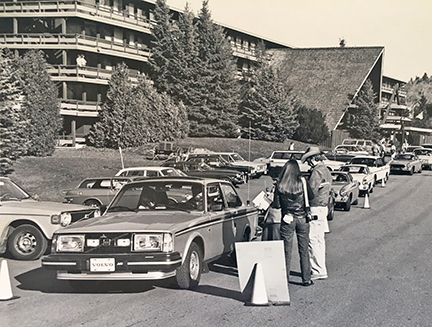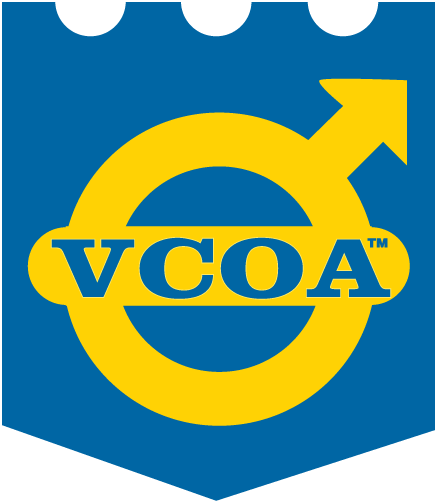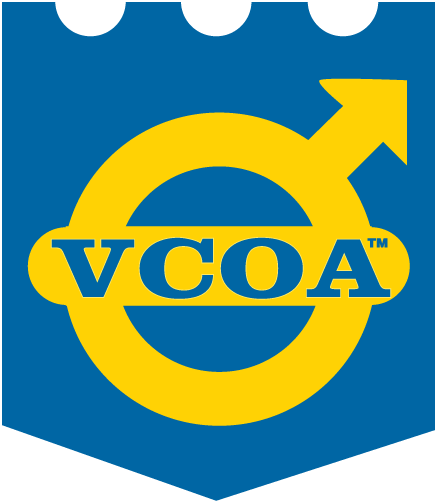About the Volvo Club of America
Since its founding in 1983, the Volvo Club of America (VCOA) has championed every model, from the classics to the current, welcoming people around the country—even beyond our borders—to fraternize over the common love of Volvo cars.
From its establishment in 1927 up to the present day, Volvo has built automobiles that are different—a bit cleverer, a bit more humanistic, a bit stronger than regulations and industry standards might have influenced them to be. Those traits have made its cars stand out in the marketplace, although they didn’t necessarily inspire widespread appeal. The people who have been drawn into Volvo ownership have tended to be independent thinkers who resonate with those values the cars exhibit. The most enthusiastic Volvo owners find camaraderie in their shared passion for the Swedish marque and its cars by joining organizations like the Volvo Club of America.

Founding of VCOA
A small group of like-minded Volvo owners, largely based in New England, had become friends by the early 1980s. They decided to form a national club catering to owners of all Volvo models, both vintage and modern—the Volvo Club of America (VCOA).
Connecticut resident Roger Salls, member #4, remembers meeting many of his future fellow VCOA founders in 1980, “We had a real love for Volvos, and we formed a fairly close bond over the belief that the marque is one that should be honored: we’d do whatever we could to promote it. When we decided to form the new club, we said, ‘This has to be about Volvo—the marque, the cars, the history.’” “We were not people who were afraid to be different. At that time, owning a Volvo set you apart from your neighbor—you were into a different type of performance, from a very rugged car.”
The group met in a rented conference room in Danielson, Connecticut, in December 1982 to create the blueprint for this club as an all-encompassing, officially recognized organization that would celebrate every Volvo automobile built, from the earliest models up to the present day. The inaugural issue of its newsletter, Rolling, was distributed to the fledgling club’s membership in May 1983. Since then, more than 32,000 people have participated in the nonprofit VCOA, and the current membership rolls count around 3,300 devoted Volvo fans.
That first Rolling spelled out the organization’s mission, “In founding The Volvo Club of America, the members of the board recognized that several other Volvo clubs already existed, including clubs in specific regions of the country and clubs catering to specific models of Volvos. It was our belief that to date no club successfully met the need which we perceived to exist in this country, namely, for a national club which welcomed members owning any and all Volvo models, from the historical and antique vehicles right up to the current 240 and 760 models.”
This group’s first members, brought together with many others by a shared affection for their cars, put a lot of effort into doing things the right way, including securing permission from Volvo Cars of North America, to use the marque name for the club. “I was the company point-man in establishing VCOA,” recalls retired Volvo Director of Marketing Communications Bob Austin. “The point-man on the club side was Duncan LaBay. I was impressed by the passion that Duncan and his colleagues had for the Volvo brand and for their desire to establish a club for all people who enjoyed all the cars that were produced by Volvo: not just the old ones, not just the sporty ones, but all the cars that wore the Volvo name. They had great respect for our brand, and they seemed to really understand that allowing an organization to use the Volvo brand in their club’s name is both an honor and a responsibility.
“Impressed by their efforts up to that point, I took their materials back to our North American headquarters in Rockleigh, New Jersey, and presented their materials to our legal department along with my recommendation to approve the club’s request to use the Volvo name in their official name,” Bob continues. “I am sure Duncan and his colleagues were sitting on pins and needles waiting to hear back from us, but I’m sure they were pleased when they did.”
With confirmation secured, the Volvo Club of America was officially live, and Duncan, member #1, would serve as its first full-term president. Now living in Maine, retired college professor Duncan looks back on the experience of establishing the club with recognition of the special role such an organization plays in the experience of owning an enthusiast automobile. “The opportunity to meet with other people who share the same enthusiasm for a marque is an important part of any car club, and our goal was to provide that socialization for like-interested enthusiasts,” he tells us. In those early days of VCOA, Duncan recalls most members were primarily interested in the earlier cars, but like today, new faces were welcome participants: “From the beginning, we reached out to current-model owners too—at that point, they would have been 240s, and we did well with the 200-series owners who were enthusiasts. It was an enthusiast group from the beginning.”
Marketing and Chapter Building
In those pre-internet times, it wasn’t easy to spread the word about this new club celebrating what was still a niche Swedish automaker here in the U.S. “We advertised in Hemmings Motor News from the beginning, and even tried a few ads in the back of Road & Track,” Duncan explains. “We also made a major push to get dealers to sign up to offer a token discount on parts or service. We made flyers and business cards that we asked members to put on the windshields of other special Volvos they might encounter.” Roger remembers their early efforts, including founder Scott Matthews walking around Connecticut’s Greenwich train station, dropping leaflets on cars and saying, “Join us!”
The formation of chapters was a big part of expanding VCOA’s reach around the country, and the club’s first one—the Nutmeg Chapter of Connecticut, now called the Southern New England Chapter—was founded by member #21, current VCOA vice president Gretchen Adams. According to Duncan, subsequent early chapters included the Philadelphia area, Central New York, and a successful one covering San Francisco-Northern California. He says, “I think the chapters have been a critical, grassroots part of the success of an organization such as this.”
Gretchen, who has since 1986 spearheaded key club-office functions, has been deeply involved with this organization virtually before it even coalesced. In a story with parallels to Roger’s, Gretchen and her husband, David (himself a future VCOA board member), owned a 1959 PV445 in 1982 when they lived adjacent to their 1800-driving Connecticut friends, Ron Kwas and Wendy Einbinder. Wendy would become an early VCOA board member who hosted club meetings to which the Adamses were invited. Gretchen and David were already acquainted with the group, having met founders Duncan, Fran, and Steve at that year’s Volvo International tennis tournament in New Hampshire, where the automaker sponsored a Volvo owners’ car show and picnic.
Club Office
How she came to run the Volvo Club of America office was a fortuitous opportunity. “I took over the membership chair duties from Fran Stuart. Up to that point, it was a volunteer position that had become too much work. The club was looking to hire someone to take care of the membership,” Gretchen remembers. “At that time, I was unemployed, so I took the position. We drove up to Duncan’s house in Massachusetts, where he had a 30-meg computer with a monochromatic screen, waiting there for us to pick up—it contained the club database. I’d never used a computer before, but I taught myself how to write the programs—it was a real evolution!
“David and I moved to Afton, New York, in 1989, and I purchased a book on MS-DOS. I managed to write code and create programs I could use for the database, use to print out member cards and mailing labels,” she continues. Since then, the VCOA office has changed with the times, and Gretchen has regular assistance from office manager Faye VanVorce in maintaining the club membership database in sync with the website; handling dues, advertising, and merchandise monies; coordinating National Meet materials; and mailing special-handled copies of Rolling.
Rolling Magazine
“The first issue of Rolling was only eight pages of twice-folded 17 x 22-inch paper,” Gretchen tells us. “We used to have gatherings in our apartment where we’d label, fold, and staple all the magazines to mail. It was an all-hands-on operation for many, many years. As we grew, we could no longer handle all that, so we had the printer turn it over to mail houses. We had more members, more money coming in, more opportunity to do things like that. But in the beginning we did it all in-house!”
The club’s magazine was, for years, published in January, March, May, July, September, and November. In 1990, Rolling had a color cover and was up to 20 pages in length. By the middle of that decade, when current Rolling editor Jan Nystrom joined VCOA, the publication was up to 22 pages and it contained listings for 16 chapters, founder Steve Seekins’ The Shade Tree Mechanic advice column, four full pages of classified ads, and three pages of Volvo dealers and parts suppliers offering discounts to VCOA members.
“The fact that you could get a discount on parts as a club member—I was doing most of my own car work at that time—was what prompted me to join,” Jan recalls. He was a regular member until 2005, when the club sent out a call asking for help with Rolling: “I wrote them and said, ‘I work in publishing, can I help?’ Gretchen (vice president) and Lee Cordner (then president) were having a tough time, and they turned it over to me. I was well aware of the production side of printing and doing layouts, but building a network to collect editorial material, editing the articles… I’d never done that before.” Thankfully, Jan swiftly got up to speed, and in the subsequent 18 years, he’s developed Rolling into the professional, well-rounded, 40-page magazine you’re reading today.
“Rolling is one of the primary benefits of belonging to the Volvo Club,” he explains. “You obviously have members who belong because of the camaraderie and going to the National Meets. But consider that of the roughly 3,000 members we have right now, around 150 go to the National Meets and other chapter events—it’s a pretty small percentage who interact in person. So, the role of Rolling is to share information with the members about current and vintage Volvos, and what’s happening at Volvo Cars.”
National Meets
Festive annual gatherings have been a key aspect of VCOA from day one. The first National Meet was held in October 1983 at the Snow Lake Lodge at Mount Snow, Vermont. It was a very hands-on affair, with everyone volunteering time and energy to make the gathering a success. “There was a good turnout of around 45-50 people,” Gretchen says. “We held a gimmick rally on the roads and had a nice car show. We returned to Mount Snow two more times before the National Meet moved on to other locations.” Duncan adds, “We had an early one in the D.C. area of Virginia because we were trying to involve the then-active group of Washington-area Volvo owners. There were a lot of 122 owners in that area, including Colin Powell, who was an active participant in the Washington Volvo Club for many years.” Through the decades, meets have since been hosted around the country, from Oklahoma to Michigan to North Carolina and beyond.
Anyone who’s had the pleasure of attending a VCOA national meet understands how much work goes into putting on such an event for a big crowd, and what a pleasure they are from an attendee’s perspective. The dedicated group of volunteers currently planning the 2023 National Meet, to be held July 21-23 in Portland, Oregon, know this firsthand, and Gretchen smilingly shares insight earned through years of meet planning: “I used to work in the bridal business, and I often say it’s nothing more than a three-day wedding, without the ceremony. You’ve got people coming from all over the place who need hotel rooms and want to be fed. If you plan everything well enough in advance, the event will run itself!”
Today’s Volvo Enthusiasts and Tomorrow’s VCOA
Over the past four decades, Volvo and its cars have changed in ways both large and small, but the people who choose to drive and celebrate the cars and the marque remain a discerning, yet fun-loving, group. As Volvo’s internal-combustion-engine vehicles are phased out and electric vehicles become the new norm, VCOA will be here to support all cars and owners. Considering this, Duncan muses, “We live in a very interesting time where cars as we know them, sales of cars as we know them, and service of cars as we know them are all going to change. I think one of the opportunities that a club such as VCOA has is to be a leader in working through the changes that we all are going to face with cars as we move forward. The whole model of personal transportation, to say nothing of ownership as opposed to rental, may potentially change. I think the challenge for traditional car clubs is to stay current with what’s going on in the marketplace and to continue to provide information and experiences for their members that are more than just useful but become part of the whole experience of owning one of those cars.
“I look forward to seeing the 50th anniversary of VCOA’s founding and seeing that we’re still doing well, growing, and are populated by people who remain enthusiastic about the brand,” he concludes. Gretchen concurs, adding: “For me, it’s always been about the people more than the cars—the cars are what bring us together and allow us to create wonderful relationships with people across the country and around the world that we probably never would have the opportunity to meet any other way.”
As the Volvo Club of America begins its 41st year, we’re stepping up our efforts to reach the next generations of enthusiasts and secure the club’s future for everyone. Perhaps the most important question that it has asked of its prospective and continuing members—starting on the membership application printed in the very first issue of Rolling—has been, and remains, “How would you like this club to help you?”


